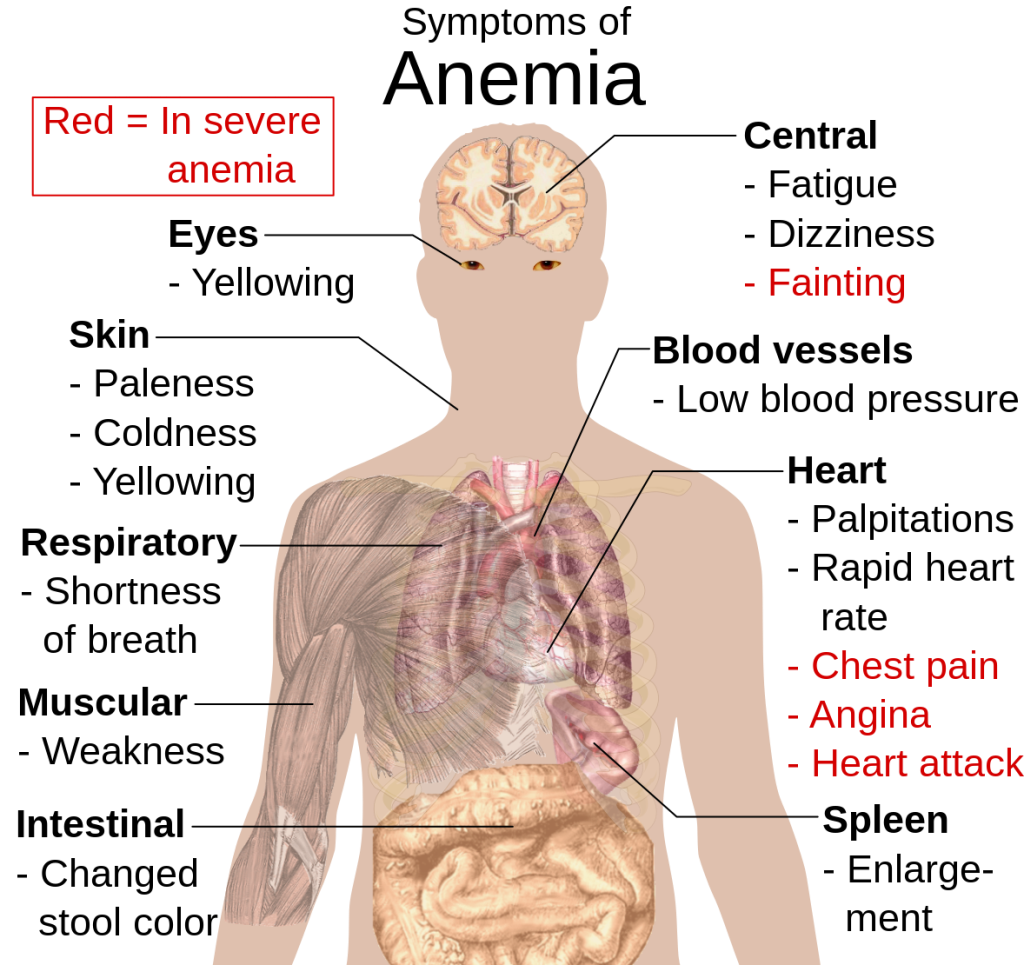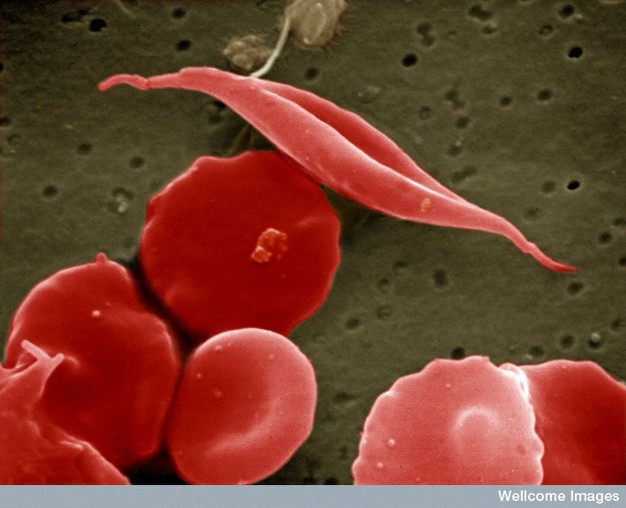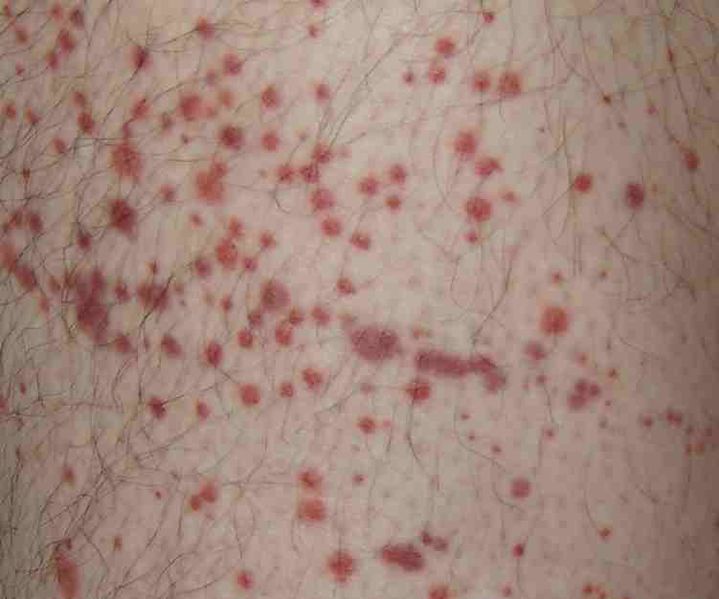10.6 Diseases and Disorders of the Blood
Anemia (ā-NĒ-mē-ă) is a blood disorder in which there is a deficiency of red cells and/or hemoglobin. Anemia is diagnosed when a blood test shows a hemoglobin value of less than 13.5 gm/dL in a man or less than 12.0 gm/dL in a woman. The lack of RBCs and hemoglobin causes a decreased amount of oxygen to be delivered to body tissues, resulting in commonly occurring symptoms of fatigue, weakness, shortness of breath, palpitations, and pale skin. See Figure 10.9[1] for an illustration of common symptoms of anemia.

There are three basic causes of anemia: blood loss, decreased RBC production, and excessive destruction of RBCs. In addition to these causes, various diseases and cancers can also cause anemia.[2]
Anemia from Blood Loss
Anemia from blood loss can result from excessive bleeding from wounds or other lesions, such as ulcers and gastrointestinal cancer. Excessive menstruation and blood loss during childbirth can also cause this type of anemia.
Faulty or Decreased RBC Production
Iron deficiency anemia (īrŏn dē-FĬ-shĕn-sē ā-NĒ-mē-ă) is the most common type of anemia. It is caused by a lack of dietary iron needed for the sufficient production of hemoglobin.
Sickle cell anemia (SĬK-l sĕl ā-NĒ-mē-ă) is genetic disorder that causes red blood cells to assume a sickle (i.e., crescent) shape that can block blood flow and cause serious problems in organs throughout the body. See Figure 10.10[3] for an image of a sickled red blood cell.

Aplastic anemia (ā-PLAS-tĭk ā-NĒ-mē-ă) is a bone marrow condition causing an insufficient production of RBCs. This condition can be inherited, or it can be caused by radiation, medication, chemotherapy, or infection.
Other Types of Anemia
Megaloblastic anemia (mĕ-gŭh-lō-plă-stĭk ā-NĒ-mē-ă) involves a deficiency of vitamin B12 and/or folate, often due to inadequate dietary intake. Pernicious anemia (pĕr-nĭsh-ē-ŭs ā-NĒ-mē-ă) is caused by poor absorption of vitamin B12 in the gastrointestinal tract. Thalassemia (thal-ă-SĒM-ē-ă) is an inherited condition typically occurring in individuals from the Middle East, the Mediterranean, Africa, and Southeast Asia in which maturation of the RBCs does not proceed normally. Pancytopenia (pan-sī-tō-PĒN-ē-ă) is reduction of all types of blood components, including red and white blood cells and platelets.[4]
Hematoma
A hematoma (hēm-ă-TŌ-mă) is a collection (or pooling) of blood outside the blood vessel caused by an injury. Trauma is the primary cause of a hematoma. Trauma can be the result of a car accident, fall, broken bones, gunshot wound, or head injury. People with bleeding disorders or those taking anticoagulant medication are at higher risk for developing hematomas from injuries. Symptoms of a hematoma include redness, warmth, swelling, inflammation, and pain and require medical treatment.[5]
Hematomas differ from bruises. A bruise, also known as a contusion (kon-TU-zhun), occurs when the small veins and capillaries under the skin break, releasing blood into the surrounding tissue. Bruises are dark blue or purple tender patches that appear on the skin within a few hours after injury.[6]
Hemophilia
Hemophilia (hē-mō-FĒL-ē-ă) is a genetic disorder in which blood doesn’t clot normally due to deficient or abnormal clotting factors. Patients with hemophilia can bleed excessively and hemorrhage from even minor internal and external injuries.[7]
Hemorrhage
Hemorrhage (HEM-ŏ-rāj) is excessive bleeding that cannot be controlled by hemostasis. A hemorrhage is a medical emergency.
Leukemia
Leukemia (lū-KĒM-ē-ă) is cancer of the bone marrow, the body’s blood-forming tissues. It includes an abundance of nonfunctional leukocytes (i.e., white blood cells), reducing the individual’s ability to fight off infection.[8] Leukemia is diagnosed with a bone marrow biopsy. Treatment may include chemotherapy and a bone marrow/stem cell transplant.
Leukocytosis
Leukocytosis (lū-kō-sī-TŌ-sĭs) is excessive leukocyte (white blood cell) production. Although leukocyte counts are high, the cells themselves are often nonfunctional, leaving the individual at increased risk for infection.[9]
Leukopenia
Leukopenia (lū-kō-PĒN-ē-ă) is a condition in which too few leukocytes (white blood cells) are produced, which impact the individual’s ability to fight off disease.[10]
Lymphoma
Lymphoma (lim-FŌ-mă) is a type of cancer in which masses of malignant lymphocytes (white blood cells) collect in lymph nodes, the spleen, the liver, and other tissues. As in leukemia, the malignant leukocytes do not function properly, and the patient is vulnerable to infection. Two main types of lymphoma are Hodgkin lymphoma and non-Hodgkin lymphoma. Hodgkin lymphoma progresses slowly and responds well to treatment if found early. Non-Hodgkin lymphoma can progress quickly and may require aggressive treatment. Symptoms of lymphoma include swollen lymph nodes, fever, drenching night sweats, weight loss, and fatigue. Treatment may include chemotherapy, radiation therapy, and immunotherapy.[11]
Polycythemia
Polycythemia (pol-ē-sī-THĒM-ē-ă) refers to an elevated RBC count. A mild form of polycythemia is normal for people living at high altitudes because their bodies create a greater number of red blood cells to carry oxygen due to decreased pressure of oxygen at high altitudes. Some elite athletes even train at high elevations specifically to induce this phenomenon. However, a bone marrow disease called polycythemia vera (pol-ē-sī-THĒM-ē-ă vee-ruh) causes an excessive production of immature RBCs and other blood components, increasing the viscosity of blood. Viscosity (vĭs-KOS-ĭ-tē) refers to the state of being thick, sticky, and easily coagulable.[12]
Thrombosis, Thrombus, and Embolus
Thrombosis (thrŏm-BŌ-sĭs) is the formation of a thrombus. A thrombus (THROM-bŭs) is a collection of platelets, red blood cells, and white blood cells trapped within a mass of fibrin strands, commonly referred to as a “blood clot.” While the formation of a clot is a normal step in hemostasis, the development of a thrombus can cause decreased blood flow in a blood vessel or a life-threatening obstruction of a blood vessel in the heart or brain.[13]
When a portion of a thrombus breaks free from the vessel wall and travels through the bloodstream, it is referred to as an embolus (ĒM-bŏ-lŭs). An embolus that is carried through the bloodstream can be large enough to block a vessel critical to a major organ. When it becomes trapped, an embolus is called an embolism (ĒM-bŏ-lĭzm). In the heart, brain, or lungs, an embolism can cause a life-threatening heart attack, stroke, or pulmonary embolism.[14]
Thrombolysis (thrŏm-BŎL-ĭ-sĭs) refers to the dissolution of a clot. Medications like tissue plasminogen activator (tPA), commonly referred to as “clot busters,” are used to dissolve severe clots causing heart attacks, strokes, or pulmonary embolism.
Thrombocytosis
Thrombocytosis (thrŏm-bō-sī-TŌ-sĭs) refers to an abnormally high number of platelets (thrombocytes) in the blood, which can cause thrombosis.
Thrombocytopenia
Thrombocytopenia (thrŏm-bō-sī-tō-PĒN-ē-ă) refers to an insufficient number of platelets, causing ineffective blood clotting and the potential for excessive bleeding.[15] Common symptoms of thrombocytopenia include bleeding gums, blood in the urine or stool, or petechiae and purpura. Petechiae and purpura are red or purple spots on the skin caused by microscope hemorrhages that do not turn lighter in color when pressure is applied. See Figure 10.11[16] for an image of petechiae and purpura.

- “Symptoms_of_anemia.svg.png” by Mikael Häggström is licensed in the Public Domain ↵
- American Society of Hematology. (n.d.). Anemia. https://www.hematology.org/education/patients/anemia ↵
- “Eritrociti.jpg” by EM Unit, UCL Medical School, Royal Free Campus, Wellcome Images is licensed under CC BY 4.0 ↵
- This work is a derivative of Anatomy & Physiology by OpenStax and is licensed under CC BY 4.0. Access for free at https://openstax.org/details/books/anatomy-and-physiology-2e ↵
- MercyHealth. (n.d.). Bruise or hematoma. https://www.mercy.com/health-care-services/primary-care-family-medicine/conditions/bruise-hematoma ↵
- MercyHealth. (n.d.). Bruise or hematoma. https://www.mercy.com/health-care-services/primary-care-family-medicine/conditions/bruise-hematoma ↵
- This work is a derivative of Anatomy & Physiology by OpenStax and is licensed under CC BY 4.0. Access for free at https://openstax.org/details/books/anatomy-and-physiology-2e ↵
- This work is a derivative of Anatomy & Physiology by OpenStax and is licensed under CC BY 4.0. Access for free at https://openstax.org/details/books/anatomy-and-physiology-2e ↵
- This work is a derivative of Anatomy & Physiology by OpenStax and is licensed under CC BY 4.0. Access for free at https://openstax.org/details/books/anatomy-and-physiology-2e ↵
- This work is a derivative of Anatomy & Physiology by OpenStax and is licensed under CC BY 4.0. Access for free at https://openstax.org/details/books/anatomy-and-physiology-2e ↵
- Medline Plus. (2023). Hodgkin lymphoma. https://medlineplus.gov/hodgkinlymphoma.html ↵
- This work is a derivative of Anatomy & Physiology by OpenStax and is licensed under CC BY 4.0. Access for free at https://openstax.org/details/books/anatomy-and-physiology-2e ↵
- This work is a derivative of Anatomy & Physiology by OpenStax and is licensed under CC BY 4.0. Access for free at https://openstax.org/details/books/anatomy-and-physiology-2e ↵
- This work is a derivative of Anatomy & Physiology by OpenStax and is licensed under CC BY 4.0. Access for free at https://openstax.org/details/books/anatomy-and-physiology-2e ↵
- This work is a derivative of Anatomy & Physiology by OpenStax and is licensed under CC BY 4.0. Access for free at https://openstax.org/details/books/anatomy-and-physiology-2e ↵
- “Purpura.jpg” by User:Hektor is licensed under CC BY-SA 3.0 ↵

